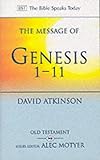 I’ve read several of the newly revised Expositor’s Bible Commentary series, but this was my first Old Testament volume. All the comments I’ve made before about the nice layout of the series apply again here, as does my reservation that it sometimes seems to fall between the gaps, not quite being an exegetical commentary for academics, and not quite being an expositional commentary for preachers.
I’ve read several of the newly revised Expositor’s Bible Commentary series, but this was my first Old Testament volume. All the comments I’ve made before about the nice layout of the series apply again here, as does my reservation that it sometimes seems to fall between the gaps, not quite being an exegetical commentary for academics, and not quite being an expositional commentary for preachers.
The Introduction
Sailhamer introduces Genesis as a book concerned with global and ‘family’ matters – it is a book with unity but not uniformity. He briefly surveys different opinions on authorship, and takes on the unwarranted skepticism of some critical scholars and seems to favour a “compositional” view. He believes the purpose of Genesis should be viewed in terms of the purpose of the Pentateuch, which looks forward to a new covenant and a Saviour-King. He observes a pattern of poems concluding significant sections in Genesis, and believes that many of the events are selected to demonstrate that the past portends events in the future. Ultimately the central concern of the Pentateuch is the rule of God among his people and within his creation. It is written as an answer to the failure of the Sinaitic covenant, and points forward beyond itself to the time of the promised “seed” of Abraham and a new covenant.
The Commentary
Naturally I was interested to see what his take on the creation account was. He suggests that a seven day week follows an unspecified amount of time. There are some detailed footnotes which rather irritatingly refer the reader to the first edition for more information! He also detects a polemic against idolatry in the creation account. The recurring description of various creative acts being “good” indicates that these developments are for the “good” of humankind. In Gen 2:15 he rejects the translation that man is to “work and keep” the Garden, but rather is to “worship and obey”. The “knowledge of good and evil” refers to Adam and Eve wanting to decide for themselves what is good and evil.
He has an interesting approach to Cain. He sees the story of the mark of Cain (Gen 3:13-14) as being one of repentance and forgiveness. He demonstrates how lots of these incidents in earlier chapters are reflected in laws given later in the Pentateuch. Here the example is cities of refuge.
The real key to the Pentateuch according to Sailhamer is found in the poems. He takes care to show that the poems link together the seed of Abraham with the coming King from Judah. They are one and the same.
In many ways it felt as though Sailhamer’s main interest in this commentary was not really to explain the meaning of individual passages (though he does do a bit of that), and not at all to suggest preaching points or applications (these come very rarely), but rather to explain why a particular story has been included, and how it fits into the overall scheme of the Pentateuch. He is always looking for links backwards and forwards (which he calls “inter-textuality”). He points out parallels between the lives of Noah and Abraham, between Abraham and Joseph, and even between Eve and Sarah. Abraham is an example of someone who had God’s law written on his heart – he obeyed it even before it was given.
He picks up on the importance of the promise of kings in Abraham’s line. Even though the closing portion of Genesis seems to focus exclusively on Joseph, the author still shows how Judah is “next in line” after the fall from grace of his elder brothers (Reuben, Simeon and Levi). Judah transcends Joseph – he will ultimately be in the royal line even if he now bows the knee to Joseph. I felt at first that he was stretching things to suggest that Judah remains the prominent character in spite of Joseph’s leading role in the narrative, but he did find more evidence for this than I was expecting.
Joseph himself is described as a “second Adam”, and is the only man in the Old Testament who is said to have been filled with the Spirit. Abraham also is a “second Adam” and Jacob’s sons represent a “new humanity”. Genesis also shows repeatedly through the struggles between older and younger brothers that God’s blessing is not based on natural rights. While he doesn’t join up the dots for you, Sailhamer certainly points expositors in the right direction to be able to preach the gospel from the Genesis story.
Strengths and Weaknesses
It was an interesting read, and didn’t tackle the kind of issues I was expecting. Many ethical and theological topics were left unremarked on. I suppose that is inevitable in a mid-sized commentary. The great strength of this commentary is that it takes a big picture approach. It develops a sense of the overall progression of Genesis and how it fits into the Pentateuch. Its weakness is that if you were to use it as a reference to get some insight on a particular verse or passage, you might find many of your exegetical and theological questions haven’t been addressed. But overall I would say it represents good value for money, as you get Exodus and Leviticus in the same volume for little more than the price of a single commentary.


